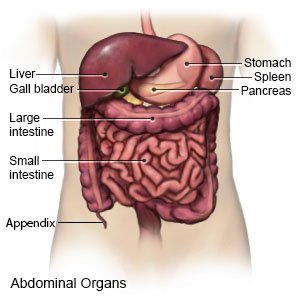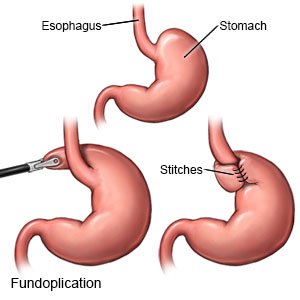Fundoplication in Children
Medically reviewed by Drugs.com. Last updated on Aug 4, 2025.
What do I need to know about fundoplication?
Fundoplication is surgery to treat gastroesophageal reflux disease (GERD). The top part of your child's stomach is wrapped around the lower part of the esophagus. This prevents stomach acid from moving up into your child's esophagus.
 |
How do I prepare my child for surgery?
Your child may need an endoscopy with biopsy (small tissue samples are taken) or a pH study before surgery. Ask your child's surgeon more about these tests. Do not give your child anything to eat or drink after midnight the night before surgery. Your child's surgeon will tell you which medicines to give or not give your child the morning of surgery.
Related medications
What will happen during my child's surgery?
- Your child will be given general anesthesia to keep him or her asleep and pain-free during surgery. Your child may be given antibiotics to prevent an infection.
- Your child's surgery may be done as an open procedure. During an open procedure, a large incision will be made in his or her abdomen. Your child's surgery may instead be done laparoscopically. Several small incisions will be made in his or her abdomen. Your child's surgeon will put a scope and tools through the incisions to do the surgery.
- The upper portion of your child's stomach will be wrapped around the esophagus. This will help the valve between the esophagus and stomach close better. The surgeon may also repair the muscles in the esophagus if they are weak. The incisions are then closed with stitches or surgical tape and covered with bandages.
 |
What should I expect after my child's surgery?
Your child may have a nasogastric (NG) tube in his or her nose. The NG tube goes through your child's nose and into his or her stomach. It will be attached to suction. This will prevent fluid from backing up into the stomach. It also allows your child's surgery area to start healing. Your child may have a catheter in his or her bladder. Healthcare providers will help your child walk down the halls to prevent blood clots. Your child can go home when he or she is eating and drinking and pain is controlled.
What are the risks of my child's surgery?
Your child may bleed more than expected or get an infection. If your child's wrap slips or moves, his or her GERD may come back. This may cause bloating or trouble swallowing. Your child may have a reaction to the anesthesia. Your child's esophagus, stomach, or other organs may be damaged during surgery.
Care Agreement
You have the right to help plan your child's care. Learn about your child's health condition and how it may be treated. Discuss treatment options with your child's healthcare providers to decide what care you want for your child. The above information is an educational aid only. It is not intended as medical advice for individual conditions or treatments. Talk to your doctor, nurse or pharmacist before following any medical regimen to see if it is safe and effective for you.© Copyright Merative 2025 Information is for End User's use only and may not be sold, redistributed or otherwise used for commercial purposes.
Further information
Always consult your healthcare provider to ensure the information displayed on this page applies to your personal circumstances.
